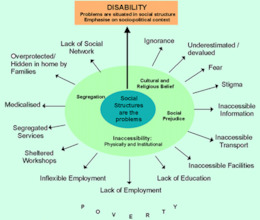Toolbox — For Training and Youth Work
All new tools in your inbox: Be the first to know about new tools for learning with our e-mail notifications.
Info session
Social Model of Disability as Youth Work Tool for Inclusion
The tool introduces the Social Model of Disability as Youth Work Tool for Inclusion.
The model is debated versus the Medical model of disability arguing that societies are acting disabling bodies and hold the responsibility and capacity to enable.
Aims of the tool
To bring knowledge and develop attitudes towards an inclusive social approach in youth work, based on the social model of disability and aiming at inclusion of young people with disabilities via provision of adequate access and opportunities.
Description of the tool
The tool presents the social model of disability as a youth-friendly approach to include young people with disabilities in youth work, education and employment.
The social model of disability is discussed in its reaction to the (still dominant in many countries in Europe) medical model of disability which in itself is a functional analysis of the body as machine to be fixed in order to conform with normative values.
The social model of disability can be used in youth work as a pro-active approach that identifies systemic barriers, negative attitudes and exclusion by society (purposely or inadvertently) that mean society is the main contributory factor in disabling people. While physical, sensory, intellectual, or psychological variations, may cause individual functional limitation or impairments, these do not have to lead to disability unless society fails to take account of and include people regardless of their individual differences.
A fundamental aspect of the social model concerns equality. The struggle for equality is often compared to the struggles of other socially marginalized groups. Equal rights are said to give empowerment and the "ability" to make decisions and the opportunity to live life to the fullest.
A related phrase often used by disability rights campaigners, as with other social activism, is "Nothing About Us Without Us."
Practical Examples:
"The social model of disability focuses on changes required in society. These might be in terms of:
Attitudes, for example a more positive attitude toward certain mental traits or behaviors, or not underestimating the potential quality of life of those with impairments.
Social support, for example help dealing with barriers; resources, aids or positive discrimination to overcome them, for example providing a buddy to explain work culture for an employee with autism,
Information, for example using suitable formats (e.g. Braille) or levels (e.g. simplicity of language) or coverage (e.g. explaining issues others may take for granted),
Physical structures, for example buildings with sloped access and elevators, or
Flexible work hours for people with circadian rhythm sleep disorders or, for example, for people who experience anxiety/panic attacks in rush hour traffic."
Available downloads:
Disclaimer
SALTO cannot be held responsible for the inappropriate use of these training tools. Always adapt training tools to your aims, context, target group and to your own skills! These tools have been used in a variety of formats and situations. Please notify SALTO should you know about the origin of or copyright on this tool.
Tool overview

http://toolbox.salto-youth.net/1445
This tool addresses
Social Inclusion, Disability
Materials needed:
Beemer, laptop, screen
Duration:
90 min
Behind the tool
The tool was created by
Borislava Daskalova
in the context of
SALTO Inclusion "TC Ability" course
The tool has been experimented in
SALTO Inclusion "TC Ability" course
The tool was published to the Toolbox by
Bo Maria Daskalova (on 11 June 2013)
and last modified
10 June 2013
Comments
No comments have been posted yet.
If you want to comment on this tool, you need to be signed in with your MySALTO account. Sign in now